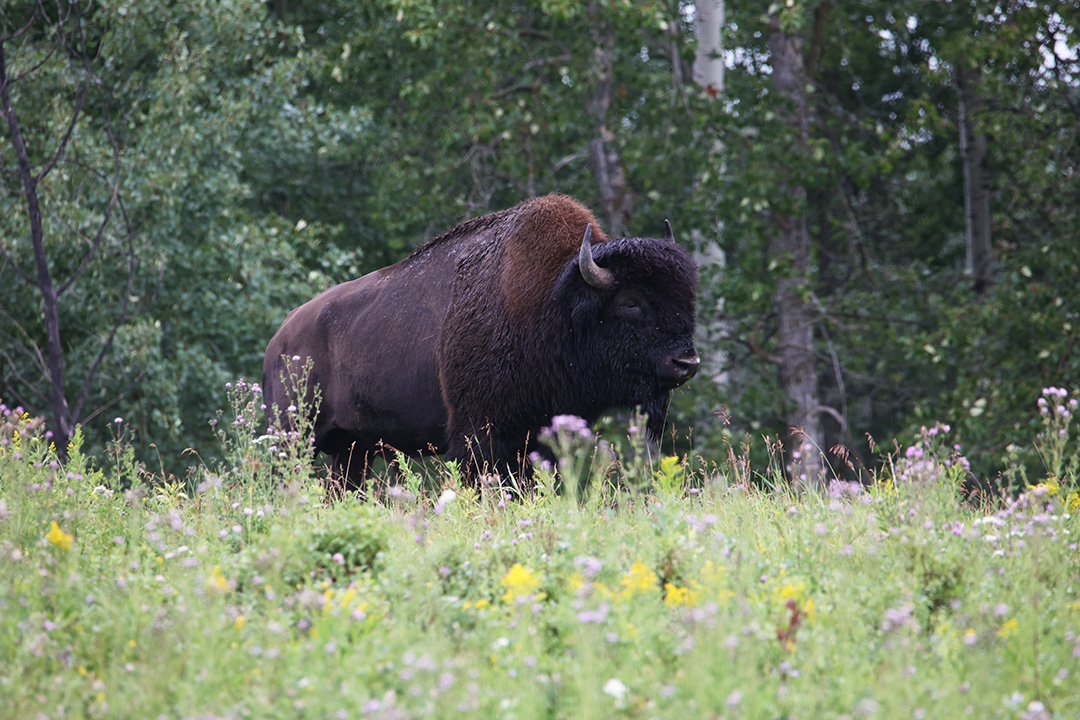
Scientists work toward goal of saving bison, one problem at a time
How can a bison cow have a calf sired by a bull from the opposite side of North America? The collection, disinfection and freezing of semen using novel technologies can make this former pipe dream a reality, and it may be our best chance of saving the North American bison species.
By Nolan KennedyWhen I became a Western College of Veterinary Medicine (WCVM) student in 2021, I had no plans to get involved in the world of research. However, a trip to the Livestock and Forage Centre of Excellence’s Native Hoofstock Teaching and Research Unit — where the University of Saskatchewan’s bison herd is located — along with a moving tale told by a pair of researchers working toward the species’ restoration made me reconsider my options.
The once dominant bison population, whose numbers may have reached upwards of 40 million, was reduced to a paltry 300 animals in the early 20th century. Over the past 100 years, conservation efforts have begun to restore some of the wild bison herds in North America, but infectious diseases such as brucellosis that are widespread in many herds present a problem for researchers who are working to save the species.
After learning about the reproductive research team’s exciting breakthroughs, I talked to WCVM professor Dr. Gregg Adams who leads this massive program. In May 2022, I began working on a summer research project that targets the use of an innovative technique for disinfecting semen before transport. This method ensures that semen collected from any bison herd could be relocated risk-free across the continent to revitalize small, isolated herds with new genetics.
BoviPure is a density gradient medium product that’s regularly used in the cattle industry to separate motile, viable spermatozoa from abnormal, inactive sperm, as well as other harmful contents such as bacteria, viruses and other debris.
To use this system, I layer the BoviPure inside a special centrifugation tube with an outer and inner chamber. The BoviPure goes in the outer chamber with the raw semen layered on top. I spin the tube in a centrifuge at relatively low speeds for 30 minutes.
The result is a condensed pellet consisting of pure motile sperm that has worked its way through the BoviPure gradient to the bottom of the tube. We retrieve the pellet through the sterile inner chamber to minimize the chances of recontamination.
But this disinfection process only solves one of the problems — the actual method of freezing the disinfected sperm also poses a slight issue. Many of the wild bison herds live in extremely remote areas where there may not be road access — much less electric power. Researchers can’t move an entire lab from site to site, so only the essentials can be taken along.
Researchers can control freezing on the collected semen samples in a full-scale lab, but this requires a large machine equipped with computer technology and liquid nitrogen tanks. This method allows for the greatest control over the rate of freezing and subsequently the highest quality sperm upon thawing.
In field settings, reproductive scientists use an alternative method called vapour freezing. This technique is crude, but it requires less equipment and time. For vapour freezing, researchers hold straws of semen on a rack about five centimetres above liquid nitrogen for 10 minutes to allow a slower cooling rate before the straws are plunged directly into the nitrogen.
While this is a more convenient method, vapour freezing results in lower motility and viable sperm upon thawing when compared to controlled freezing.
One potential solution is to hold the collected bison semen in an incubator at four degrees Celsius and then ship the sample overnight to the closest lab to undergo a controlled freezing procedure. Our hope is that this compromise, which reduces the metabolic demand on sperm, will provide us with higher quality sperm after thawing in comparison to vapour freezing. If this method is effective, it will also reduce the equipment that the team needs to bring to remote locations.
These two problems represent only one small part of this immense, multi-year research initiative that involves people from different disciplines and organizations across North America. Solving these problems will help to propel this research further, but there are still so many challenges facing the research team as they work to preserve North America’s wild bison population.
Despite only working with this team for a summer, their wealth of experience has helped me gain a much greater understanding and appreciation for all the work that goes into research and a better understanding of what it takes to make groundbreaking discoveries.
The work we completed and the mentors that I’ve gained on this project will also help me to become a more well-rounded veterinarian and aid me as I learn about more advanced reproductive techniques
Nolan Kennedy of Pritchard, B.C., is a second-year veterinary student at the Western College of Veterinary Medicine (WCVM) who worked as a summer research student in 2022. His story is part of an article series written by WCVM summer research students.
